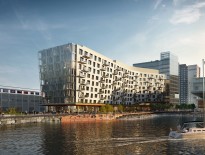Rebecca Berry
Title: President, Finegold Alexander Architects
Age: 44
Experience: 18 years
Rebecca Berry was recently elected president of Boston-based Finegold Alexander Architects, a firm that has carved out a niche in preservation and adaptive reuse projects over five decades. A triple-MIT graduate, Berry served as a construction supervisor with Americorps, building homes in Georgia, Alabama, Romania and Hungary. At Finegold Alexander, Berry has served as director of sustainability and led its worship, housing and higher education practices. As secretary of the Boston Society of Architects, Berry is active in the group’s civic policy task force tackling issues such as the region’s housing affordability crisis.
Q: Tell me about the Boulevard condo tower on the Greenway: how many hoops did you have to jump through in permitting?
A: It was very intense. Between the location on the Greenway, the sheer number of shadow studies, dealing with the Bulfinch (warehouse) building, which practically disintegrated on us when we started doing demolition. Of course, Landmarks (Commission) was involved. You attach the name Charles Bulfinch to anything, no matter how small, and it becomes the third rail. You can’t touch it. We must have done 30 or 40 schemes for how to deal with that little existing piece of the building. Never mind the fact we’re going to have the first automated parking system in Boston, and we’re building over the I-93 tunnels.
We had to deal with utility issues. We ran into a Comcast duct bank and it was right before the Olympics. They wouldn’t do a damn thing until after the Olympics was over. They didn’t want to interrupt their service. They said, “Forget it.” And they can, because they own the duct bank. The slurry walls are all complete and we’re doing excavation now.
Q: You’re also finishing up the Lucas in South End with the same developer, New Boston Ventures?
A: It’s at the former Holy Trinity German Church at 136 Shawmut Ave. The curtain wall is all up, the first (buyers) are starting to occupy late summer. We took everything out, just the church walls were left standing, and built a whole new frame inside. That was quite a project. It was really controversial because, you know, another church (becoming) luxury condos. People just get a little up in arms about these things. But the real thing about unlocking that building was just keeping the walls. From a structural standpoint it was fascinating. Normally you have to do shoring. The walls were so thick, we didn’t have to do shoring. It reminds me of those World War II pictures of the hulking church masses bombed out. In this case, it was deliberate: take it out to start fresh and new.
It’s totally sold. People get in early and do some of their own selections. It’s tricky. Sometimes it’s hard to explain to people’s very expensive interior designers that, “No, I can’t actually move that plumbing wall for you.” We find that to be a real challenge working with these high-end luxury buildings, the desire for a degree of customization. At the Boulevard, we’re doing prestressed slabs. You can’t move anything. Realtors are trying to pre-sell as many as possible and come back and say, “What if we did this? We could move the project more.” We’ve gone through some interesting exercises. You’re chasing the market the whole time, right up until you close the building.
Q: How did you decide which automated parking system to go with?
A: That took months. There were several issues. The site is extremely tight. It’s an odd shape. We have a very prescribed way we had to enter the building, off the side alley. We could not enter off the Greenway and they didn’t want us to go off Broad Street. It came down to who could build it in that space and who was affordable.
Q: What’s your goal for Finegold Alexander’s future niche in the industry?
A:Finegold Alexander traditionally has had three major areas: the public institutional work, the private institutional work and the private developer work. We still see ourselves moving forward in all those areas. When people think of us they think [of] preservation, restoration and adaptive use. We have this very solid foundation of a Boston-rooted firm. A lot of work in New England. We see building on that, broadening our client base in all of those areas, and beginning to reach out. Think beyond Boston, beyond New England, more of a national presence.
We’ve had some conversations with other firms about teaming, which is an important aspect of the future of the profession. We’d like to get to the sweet spot where we’re the design architect and we work with folks as an architect of record or a true joint venture. We’re working on increasing our in-house knowledge around technology and visualization. That’s been a big effort of (Principal) Jeff Garriga. Architecture firms are going to have to have more of that capability in-house. We have a very strong presence in public libraries and recently we’ve done some 360-degree views inside spaces and you put on the goggles and see how the space works. We took those to a library conference recently and it was a pretty big hit.
Q: Here’s something I always wonder about walking past 77 North Washington St.: What’s the story with the Scotch ‘n Sirloin sign remaining nearly 30 years after the restaurant closed?
A: I’m not sure. Apparently we used to get the occasional leak from the beer taps. People would come in to work and there would be beer on the floor and the tables. I guess the Celtics used to go there after the games. (Senior Principals) Mo (Finegold) and Jim (Alexander) have talked about running into the guys in the elevators.
Berry’s Five Favorite Ski Trails
- Mechanic’s Bowl, Alta, Utah
- Blue Sky Basin, Vail, Colorado
- Birds of Prey, Park City, Utah
- Avalanche, Cannon Mountain, New Hampshire
- Wicked “Hahd,” Cannon Mountain, New Hampshire









